The Horlogerie Dictionary
A
Stainless Steel
An extremely durable metal alloy whose main ingredient is chromium, immune to rust, discolouration and corrosion. Stainless steel can be polished to look like a precious metal.
There is a steel 316l Which has an advantage to this great resistance to corrosion and its excellent durability.
Acrylic
Low-cost plastic material used in the manufacture of watch glass. Acrylic glasses, also called plexiglas, have the particularity of being polished in order to erase the minor stripes.
Alarm
Horloger replication that sounds an alarm at pre-selected or regular intervals.
Alternating
A term for the displacement of a pendulum or pendulum between two extreme positions (A 'and A'). Two alternations, one round trip, form an oscillation (tic-tac). The pendulum of a mechanical watch performs between 5 and 10 alternations in the second, while that of a quartz watch in fact about 20 seconds.
Atmosphere (ATM)
The normal atmosphere designated by the ATM symbol refers to a pressure unit equivalent to 1013 hectopascals or about 1 bar. This unit determines the seal of a watch, namely its resistance to the pressure.
Automatic
Type of motion equipped with an oscillating mass carrying out rotations thanks to the movements of the wrist in order to arm the motor spring of a watch.
Analog
In the world of watchmaking, the term "analog" refers to watches that have an analog time indication system, that is, the user is aware of the time by moving needles that indicate, as a general rule, hours, minutes and seconds, on a dial that can be divided or not. This type of display may be accompanied by an alphanumeric or numeric display which, in turn, gives time indications through a point or letter window.
B
Baguette
A watchmaking term that describes a movement of a rectangular shape that is elongated and relatively flat. One of the best known is the famous Corum Golden Bridge.
Balancer
The pendulum is the organ which, by its oscillations, regulates the movement of a mechanical watch. Generally, the pendulum is connected to a spring named spiral which allows it to carry out a movement of a back and forth in a perfectly regular way. It is this movement which divides the time in equal intervals called oscillations (the famous " Tic-tac " If characteristic of watches). In quartz watches, it is an electric motor operating with a pile that allows the movement of a-and-back, not the spiral.
Illet
Mince box cylindrical, inside which is housed the spring motor, whose dented edge results in the rusting of a mechanical watch. The role of the cylinder is to accumulate the energy produced by the reassembly system, automatic or manual, to diffuse it to the various gears of the movement.
Bar
Small metal rods attached between the horns on both sides of the box and on which the bracelet is attached.
Enclosure
The housing (or box of watch) protects the mechanism of dust, humidity and shock. There are many shapes of boxes (round, square, rectangular, etc.) that differ from one model or brand to another. Beyond the mechanism, the box contains the dial and the hands. The central part of the housing is called the carrure; it contains the mechanism, the dial and the needles.
Loop
Body that makes it possible to close the wristband of a watch. There are two large loop systems that each have their supporters: the barbless loop and the rolling loop.
Barbless Loop
In watchmaking, we usually speak of barbless-loop wristband. More specifically, the barbless is the piece penetrating one of the holes in the bracelet, thus allowing the closure and maintenance of the wrist on the wrist of the user. This form of loop is the lightest. As such, it is often found on the finest watches.
Deployed Loop
A deployant loop is a model of clasp associated with a wristwatch. It is articulated and deploys when it opens. The deployed loop has two major advantages: safety-the comfort, the two parts of the bracelet are never unlinked, if the loop opens by accident, the watch stays around the wrist without falling.
Push buttons
These buttons on the case enclosure ensure that certain complications are affected, such as the chronograph's downtime, shutdown, and zeroing.
Bracelet
Made of leather, metal, rubber, plastic, nylon, etc. This is the link that allows you to wear the watch around the wrist.
Bronze
Combination of copper and tin (sometimes containing zinc or lead) resistant, unalterable, of a beautiful dark color with sound properties.
C
Dial
A brass plate (in general) attached to the movement by feet that are blocked by the dial screws or by the dial keys of the movement (the keys cause a notch in the foot which implies that the dial is well in place before pushing them against the feet).
Perhaps also held in a circle of dials.
Cc
The COSC, Swiss Official Control of Chronometers, is an organization that awards the chronometer title to the watches subject to its approval by the marks. All certificates are individual. The watch undergoes various tests to test its reliability, its accuracy, in different situations, with variations in temperature. This certificate is a real guarantee of quality.
Cabochon
Precious or fine stone, polished but not trimmed, sometimes decorating the crown. It is also a type of ornament used on the dial.
Perpetual Calendar
The perpetual calendar is a horological complication that takes into account leap years and automatically corrects the date regardless of the number of days in a month (28, 29, 30.31). The perpetual calendar does not require adjustment before the year 2100.
Calibre
Now shows the movement itself, its reference. Originally, the calibre designated its dimensions and then its shape, its bridges and its origin.
Square
In watchmaking, it is called carrure the middle part of the housing in which the movement is placed. The main part of the housing, the carrure is one of the three components of the box with the box background and the refractor.
Ceramics
Ceramics is a non-metallic digital material subjected to a specific treatment in a high temperature environment. There are many types of ceramics. All with unique properties adapted to different applications, such as medicine or watchmaking. Ceramics is in radiable, hypoallergenic and resistant to any type of chemical attack, high temperatures, friction and abrasion. High-tech ceramics combine timeless elegance with a pronounced refinement that make us forget a toughness that is difficult to match.
Timeline
Shows hours/minutes/seconds equipped with a complication to start, stop and then reset a needle to the request. It is usually completed with subdials of minutes and hours to total the number of towers of the main needle that counts one event per second.
Clous of Paris
Aesthetic finish used mainly on the dials of classical watches. It is, in fact, a particular type of guild, one of the most used in watchmaking, consisting of cranked lines interwoven to form small pyramids.
Complication
Any additional function to the simple indications of hours, minutes, and seconds.
Horn
In a box of wristwatches, these are pieces of various shapes that usually marry the shape of the carrure and are used to attach the bracelet.
Counter
3 Meters Timer Timer
- Trailing Meter: the needle moves slowly and continuously.
- Half Snapshot Meter: the needle is moving To the 58th second and jumped at the 60th.
- Snapshot Meter: the needle jumps abruptly to the 60th second.
Côtes de Genève
Also known as straight or wave ribs of Geneva, the shores of Geneva are an element of decoration of watchmaking movements. They represent wavy lines reminiscating the waves of the sea. This decorative touch is made mainly on the visible surface of the bridges. The luxury watches decorated on the shores of Geneva are done in a traditional way thanks to a rule to be made or through the use of a tower.
Crown
The wreath (wreath) is a button on the outside of the box and connected to the movement that is entered between the thumb and the index to raise its watch, adjust the time, or all other indications such as the days of the week, the date, etc. Some wreaths, especially those of the diving watches, are screwed to the housing to ensure a greater seal of the watch. Sometimes the wreath crown also assumes the chick role, and is used to trigger the chronograph mechanism or any other function.
D
DLC
DLC,Diamond Like Carbon, is a treatment in the mass that substantially mellow the steel of the watch. It is an alloy that combines the structure of carbon with that of the diamond for optimum resistance. It is thanks to the treatment of ionization, a process from the fields of Formula 1 and aeronautics that one can inoculate to show this unalterable treatment.
Dual time
Complication to display two simultaneous time zones, usually the time zone where the bearer of the watch is located and the one in which he is located (especially when travelling abroad).
E
Etanchity
All watches have a level of sealing expressed in meters or bars (1 bar ~ 10 meters ~ approximately 33 feet). This level of sealing corresponds to a technical standard and means that the watch resists the pressure which reigns at the depth in question (e.g. 50 m), during a static immersion. On the other hand, any movement on the part of the bearer (jumping, swimming, diving) or water (water jet shower, current, waterfall) greatly increases the pressure that the watch undergoes. As a result, the owner could not carry it up to the theoretical maximum depth corresponding to the degree of sealing. Indeed, the level of sealing refers to the activities to which a watch is intended, as mentioned in the table below.
F
Enclosure Background
The bottom is one of the three main parts of the housing with the carrure and the eyesight. The bottom of the housing is opposite to the refractor, it is generally full, but it can be transparent to let the motion look. It can be hinged, with screws (with a screw mounted with a screw), fixed by screws or fixed by pressure.
Frequency
The frequency of a motion designates the number of oscillations to the second, either the va and comes from the pendulum. It is measured in hertz. The higher the frequency, the more precise the movement is: 21'600 A/h (3 Hz), 28 '800 A/h (4 Hz), 36' 000 A/h (5 Hz).
G
GM
Abbreviation for Greenwich Mean Time. Sometimes it is also used in French TMG for " Greenwich Mean Time ". Originally created for Pan-Am and the U.S. Air Force, this concept refers to a complication that allows time to be given on two time zones at the same time: the current time at the place where one is located and the time at which it is located.
Guillochage
The guild is a decorative engraving technique used on the dial or on certain pieces of the watch. These engravings form lines or curves that cross or interconnect with regularity and symmetry. The guild can be carried out in the burin or in a tower.
Window
The window allows to leave and pass various indications through the dial as, the date, the day, the moon, the months etc. ....
I
Index
In watchmaking, an index (sometimes written indexes in the plural) is a marker located on the dial of a watch that indicates the hours. Usually in the form of a thin-line marking (it can be also round, triangular, in broad line, etc.), the index is thus used to graduate the time on a dial. It replaced over time the indication of the hour from 1 to 12 with Arabic numerals or Roman numerals, which allowed the design of the dials to evolve. The indexes and numbers can be combined on a dial and you can find a little bit about anything: only indexes, numbers and indexes combined on the whole dial, 12 indexes and 4 digits (only the 12, 3, 6 and 9), etc.
J
Sealing Joint
In the watertight watches, the seals are indispensable to the hermetically sealing the various parts of the housing, such as the bottom, the crown, the pushers and the glass. Joints can be of a variety of materials: rubber, neoprene or plastics. They absolutely must be changed after each opening of the housing if one wants to maintain a complete seal.
L
Luminova®
Luminova ® is a luminous substance deposited on the needles, figures or index of a watch. It absorbs light and restores it in the dark, giving these elements excellent visibility. In the past, the substance that assumed this function contained radium, radioactive properties. It was replaced by tritium, then by Luminova ®, a registered trademark.
Lunette
Part fitted to the carrure of the housing and which carries the glass. It can be fixed or rotating.
Lunette Lunette
Rotating, graduated and arranged on the upper part of the housing. It is used to record additional data such as the duration of a phenomenon and team, in particular the dive watches. It can be bi-directional (which turns in both directions) or one-way (which turns only in one direction). This technical limit thus makes it possible to avoid any danger, especially when one wants to measure a dive time. Any incident or mishandling can only reduce the limits initially set in terms of air supply or decompression time.
M
Manual
It is said to be a mechanical watch that goes up by hand, or manual reassembly.
Oscillating Mass
Also called rotor, the oscillating mass is a device allowing to arm the spring motor of an automatic movement, or reload the watch. It is a half-moon-shaped metal part that rotates freely in both directions thanks to the movements of the wrist.
Mechanical
Traditional movement whose operation is regulated by a pendulum and whose energy is transmitted by a reassembled spring, either by hand using the crown, or automatically thanks to the movements of an oscillating mass also known as the rotor.
Mineral
Type of glass, either glass of watch, made from glass in the traditional sense. It is an affordable glass, relatively resistant to impacts and insensitive to the UV rays.
Movement
The engine of a watch, a set of internal mechanisms that advance the needles and animate different complications. A movement is either mechanical or electronic.
N
Nacre
The nacre is a hard and iridescent material that covers the interior of some shells, including the abalone, the oyster and the mussel. It is mainly composed of calcium carbonate deposited in fine layered layers. In Western culture as in Eastern culture, nacre has long been used as a decorative inlay and in finished products. Materiau natural never completely identical in its appearance, mother-of-pearl is an excellent choice for anyone looking for a truly unique watch. New technologies make it possible to obtain nacre of varied color, from white snow to blue night.
O
Oscillation
The oscillation is the passage of the pendulum from one extreme point to the other, and then the return to its initial position. An oscillation therefore represents two alternations.
P
Phases and moon ages
A moonphase watch reproduces on its dials the different aspects of the moon during its cycle. In watchmaking the lunar is divided into four phases: new moon, first quarter, full moon and last quarter, performing a complete cycle in 29 days, 12 hours, 44 minutes and 2.8 seconds, or about 29 days and a half, while the duration of a real lunar is 29.53 days. This system results in an offset of one day in 2 years, 7 months and about 20 days. The most sophisticated are equipped with a moon phase called "astronomical" which requires only one day correction every 122 years. Some watches also show the age of the moon, the number of days since the new moon.
Physical Vapor Deposition (PVD)
Physical deposition in the vapour phase in French. The PVD is a process of metallization allowing to deposit thin films of material in vacuum thanks to steam. It allows, for example, to replace the gold plated with a less expensive material.
R
Automatic Override
The action of the mechanism that controls the motor spring of a mechanical movement through an oscillating mass, the rotation of which is carried out thanks to the movements of the wrist.
Manual Override
Action of armament of the spring of a mechanical watch by turning the wreath manually. It is also possible to trace an automatic movement manually.
Walking reserve
This is a complication to show the remaining operating time of a watch without the watch needing to be raised or worn in the case of an automatic reassembly watch. The walking reserve can be displayed in hours or days on the dial.
Rubis
A naturally very hard stone composed of red aluminum oxide and corundum. It is used to make the bearings of a movement in order to reduce the friction phenomenon. Almost all watches are now equipped with synthetic ruby. An automatic quality movement has at least 17 rubies.
S
Sapphire
Synthetic glass made from corundum, a crystal having the same chemical properties as the natural sapphire and having a hardness almost as high as the diamond. This type of glass is known for its resistance to scratches.
Subdial
A small dial used for various purposes such as the 24-hour time display, the elapsed time in minutes/hours on a chronograph or even the date.
Skeleton
Designates a type of motion whose platinum and bridges have been added in order to be able to glimpse the organs of the watch. A skeletal movement thus allows to observe the movement from the dial and the bottom of the box.
T
Tachymeter
A measurement scale for calculating the speed, usually in km/h and on a 1000 metre base, presents on certain chronographs.
Titanium
A greyish-looking metal having the property to be 30 % more solid and almost 50 % lighter than steel. It is also resistant to corrosion caused by salt water. Titanium is used in particular for sports watches, especially for diving watches.
Telemeeter
Time-show equipped with a telemetric scale, either to calculate the distance of an event based on the speed of sound.
Tourbillon
In clockwork a whirlwind, also called a "rough cage", is a watchmaking complication, added to the exhaust mechanism, intended to improve the accuracy of mechanical watches by counterbalancing the disruptions of the balancing isochronism due to terrestrial gravity. This mechanism was invented by the French watchmaker Abraham-Louis Breguet. This device is very complex to achieve, which is why it only teams very few mechanical watches.
V
Helium valve
Models designed to be waterproof at large depths (1000 to 3000m) are equipped with helium valves. This system of extreme performance allows for the pressure to be balanced between the interior and the exterior of the watch. From an internal pressure of 3 bars, the valve automatically evacuates the helium accumulated during excursions made at large depths, which prevents the casing from explosion.
---------------------------------
WHY THIS HORLOGER LEXIC?
VogtimeMakes this lexicon watchmaker available to you to our team of watch enthusiasts to ease the curiosity of neophytes or to deepen the technical knowledge of watchmakers. We enrich this lexicon regularly and hope you will find the answer to the questions you ask yourself. If you cannot find the answer to your question, we recommend that you refer to the lexicon of the High Horlogery Foundation, recognized as one of the most complete online.
APPROFUND YOUR HORLOGER CULTURE
You like watches and would like to perfect your knowledge? To help you understand the terms used on our site, the Horel team has prepared a full section dedicated to the watch culture. Novices as well as warned amateurs will find lights on the unavoidable subjects, both at the level techniquethan of themaintenanceof your timepieces.
COMPENDING THE TREATMENT OF THE MONTERS
You have a watch or are about to buy one and you see it is waterproof at 50 meters. You think it’s much more than you need because you’ll never go to such depths and it’ll be perfect to go to the beach this summer. Big mistake. An error that may prove fatal to your watch.clockwork sealingis strongly conducive to confusion and the final misunderstood by many people while yet it is fundamental information. Before buying, this will allow you to choose a watch that suits your needs and uses.
THE NOTION OF HORLOGERY DISCOUNT
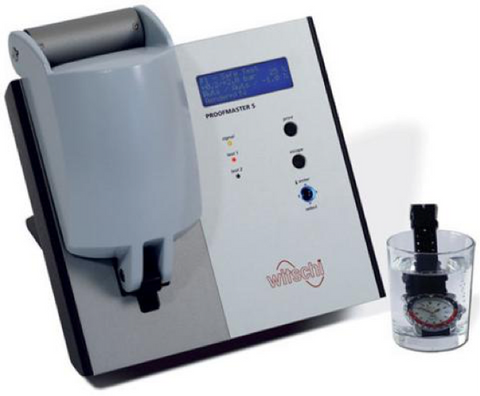
It is a basic question but it deserves clarification. clockwork, sealing refers to the ability of a watch to resist water penetration. According to the origin of the watch, it can be expressed in bars (atm for atmosphere), in meters (m) or in feet (ft). Bars or atmospheres correspond to a mechanical stress experienced during immersion, also known as overpressure. The meters or feet are theoretically an equivalence corresponding to a depth of immersion. Even if these units are different, their aim is to measure the same, or overpressure proportional to the immersion depth. For example, a watch showing a waterproof of 5 bars can in theory be submerged at 50 meters deep. However, this notion of overpressure is based on a static environment, so disregarding movements in water that can drastically increase the actual overpressure to which your watch is subjected. Be careful, therefore, of the indications provided by the brands themselves which too often lack clarity.
THE INDICATIONS OF SUPPLY TO RESPECT
In order to ensure that the leakage indications are no longer abstract to you, we summarized the instructions to follow according to the actual strength of your watch. By following the following tips, you make sure you do not encounter problems related to sealing limitsSo here's what you should remember:
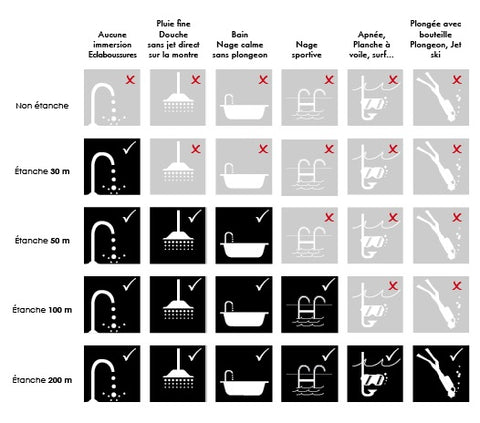
RÉSISTANCE DES EAU / 0 ATM
If your watch is Water Resist and no mention is specified, it means that is not water resistant not. It is contradictory, but the watch must not be worn in wetland. In contrast, it is will resist perspiration.
30 METRES / 3 ATM
If your watch displays a sealing mark at 30 metres or 3 ATM, it is not suitable for shower, bath, let alone bathing or dive. It will withstand moisture as well as accidental exposure to water such as rain or splashing.
50 METRES / 5 ATM
For a watertight watch at 50 meters or 5ATM, a first level is happening. It is possible for you to use your watch, exceptionally, for swim.But station to dive that will cause too much overpressure to the watch. Idem for shower and bath.
100 METRES / 10 ATM
If your watch has a 100 metres or 10 ATM waterproofness, it is a resistance that begins to become truly interesting. You can swim sports and dive in a pool in a reasonable way.
200 METRES / 20 ATM
A watertight watch at 200 meters or 20 ATM is suitable for dive, at sports swimming, but especially at theunderwater divingbut without a bottle, or the practice of snorkeling. It's a standard for most diving watches.
300 METRES / 30 ATM
With a watch with a sealing of 300 meters or 30 ATM and more, you can all enjoy it. You can really dive, swim sports, practice aquatic sports and especially do aquatics. underwater diving with bottlesand deep water.
BETWEEN THE STANCHITY OF HIS MUNTER
Note that thesealingis not a permanent feature. Thus, if condensation appears on the glass of your watch, you need to quickly and have it controlled by your watchmaker and above all stop immersion. There are exceptions due to temperature gaps, such as getting out of a car air conditioned by a very hot weather. Anyway, it is recommended that the sealing of his watch be checked every 3 to 5 years if you do not go through the water regularly, if not every year. If your watch is fitted with a quartz movement, also note that a change of stack requires re-tightness to achieve the performance shown on the watch. Every time the box bottom is opened, you have to do a check.
THE MOVEMENTS OF THE MONTER:
All watches are equipped with movementsallowing them to set the time and then measure the time. internal mechanismswhich advance the needles and which annihilate the various complications such as a date, a chronograph, a perpetual calendar, a GMT function, and many others. The movement is therefore an essential component to retain the accuracy of its watch which could not work without.
WHAT MOVEMENT OF AMONTER CHOISIR?
There is two major movement familieswatches: mechanical movements and electronic movements. The former are only composed of mechanical parts such as wheels and springs while the latter possess an electronic circuit requiring a battery to operate (although in some cases they may also be equipped with mechanical parts as a complement). Choosing a move is also a function of your budget. electronic movementsare more widespread, inexpensive and very precise while the mechanical movementsare more expensive, less accurate and require maintenance. First of all, the logical choice would therefore be to move forward with simplicity and efficiency. Despite everything, choosing a mechanical watch is choosing a lifestyle and the charm of a complex construction. Any watchmaker will end up, whatever happens, crossing the course of acquiring a mechanical piece. In the end, the point is to please yourself.

MANUAL REMONTING MECANIC MOVEMENT
Often called manual movements, the manual reassembly mechanical movementsare the oldest types of watch movements ever made, drawing their origins from the 16th century. Therefore most old watches are equipped with them. These movements require remounting every day in order to function optimally and the adjustment must be made once the watch is removed from the wrist in order to avoid any damage to movement. When you go back up this motion type, you have to do it until you feel a small tension at the crown level and especially not force because it could damage the movement.
MECANIC MOVEMENT TO REMONTINGAUTOMATIC

Also called automatic movements, it is a variant of manually reassembled mechanical movements. These store energy through natural movements of the watch-carrier wrist through the addition of a rotor (also called oscillating mass) that goes up the main spring perpetually, a system invented by Rolex in 1930. Automatic movements can also be reassembled manually, especially when the watch has not been worn over a period of more than the restraint period of movement (approximately 40 hours). It's the most popular type of movementwith watch lovers because it does not require daily setting.
QUARTZ ELECTRONICAL MOVEMENT
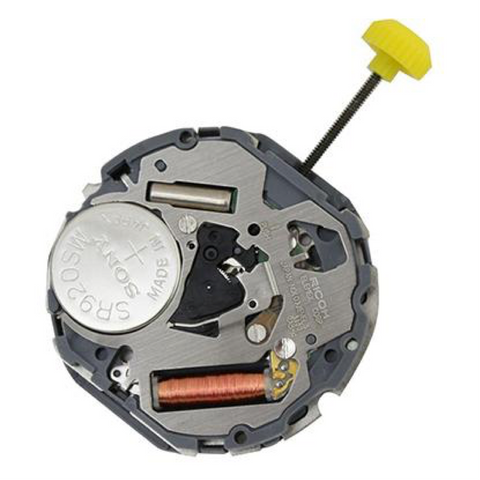
The quartz movementsuse a battery as a primary power source. This sends an electric current into a small quartz crystal in order to electrify it, creating virations that swing the movement and drive the needles. These movement typesare very accurate and require virtually no maintenance except battery replacement that usually lasts 2 years. Their cost is also very low because these are made up of very few parts. In the eyes of watch lovers, these movements are not very interesting in terms of technicality or know-how compared to mechanical movements.
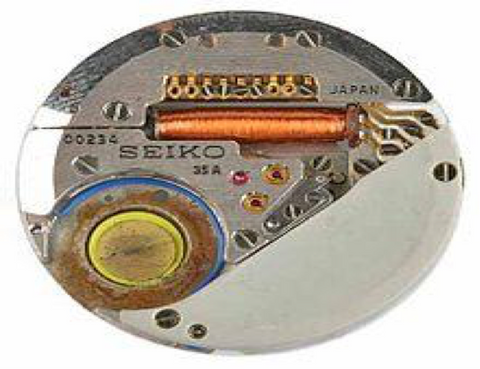
ELECTRONICAL MOVEMENT TO SOLAR QUARTZ
The solar energy movementsare also electronic movements that do not, however, have a stack. They are powered by a small solar panel located on the dial that recovers solar or artificial light to transform it into electric energy and then to store it in a rechargeable batteryor in a capacitor. This energy can then be used when the watch is not exposed to light for several months. So these are movements that protect the environment (just like mechanical movements) because they do not require a change of stack containing harmful chemicals.
ELECTRONIC MOVEMENT TO KINETIC QUARTZ
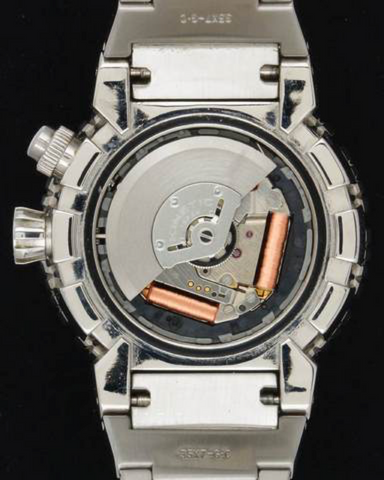
The kinetic movementsquartz, also called auto quartz, are electronic movements on which a oscillating mass has been mounted. This rotor rotates, as does an automatic watch, depending on wrist movements and perpetually in order to generate an electric current stored in a stack or capacitor. It is a system made famous by the Japanese brand Seiko that gave it this name: Kinetic, in reference to kinetic motionwhich characterizes the operation of automatic movements. It is a relatively rare type of movement in the watch market and very little used by other brands.
What's the CALIBER of a MONTRE?
This term originally referred to the dimension of a watchmaker movementthen evolved to be used to refer to the form of motion and its components. Now the notion of caliber simply refers to the reference of the movement of a watch, or the name of the motion modelEach manufacturer uses its own codes, so it is difficult to find itself there. On the other hand, the size of a brand refers to the origin of the brand, which is registered at the Federal Office of Marks and the Swiss Federation of Horlogère Industry.
WHAT MAY I MUST REVISE MUST MUST BE MUST?

Themotion of a watchis like a car engine: you have to keep it up, be careful then have it revised. This is not the case for quartz movements. Thus, oils present in the coils of a mechanical motiontend to dry, friction of parts against each other to produce metallic microparticles or even some parts to break. All of these factors therefore have an influence on the efficiency of motion, whether it is a lack of precision, alteration of the operation of a complication, or even the general operation of the watch. For the record, have your watch reviewedby a watchmaker is important to keep walking your timepiece. The time frames between revisions depend on many parameters but for the vast majority of watches, a revision every 5 to 7 years is needed. Most of the time, these revisions cost between 200 and 500 euros for large brands (and can rapidly climb according to brand exclusivity). Depending on where the revision is conducted, this process takes between 1 and 3 weeks.
THE TYPES OF MONTRE GREEN
The glass of a watch, also called watch ice, is the transparent part that protects the dial as well as its needles from dust and water and then allows the indications to be read. This part of the watch is commonly referred to by the word "crystal" in English, an expression that you will meet regularly on foreign brand sites. Not to be confused with the quartz crystal that denotes the small quartz piece that serves as an oscillator in a quartz electronic watch, these two terms having nothing to do with each other.
THE MATTERIALS OF THE MONTREL GREEN
In watchmaking, the glasses are made up of composite materialseven though they were originally made of glass. The development of treatment techniques has created high quality glasses that are both shock-resistant and scraping, as well as with a nearly zero coefficient of expansion (pressure resistance or temperature) to ensure high stability and increased longevity. There are three great ones glass familiesproducts and used in the manufacture of watches:
THE ACRYLIC GREEN
Similar to plastic and also known as plexiglass, the acrylic glassis the most affordable type of glass but also the least resistant to stripes and cracks during impacts. In contrast, he possesses the characteristic of being able to be polished in order to erase minor stripes, thus giving him his brilliant and transparent. It also has the characteristic of being able to be moulded in order to obtain particularly elaborate forms, something impossible with the sapphire or mineral glasses.
THE MINERAL GREEN
Used in clockworkfor hundreds of years, mineral glass has been simply made of glass in the traditional sense of the term. It has low resistance to stripes and like acrylic glass, these cannot be repolished. It can become, however, more resistant thanks to various treatments. It is a very affordable type of glass, more impact-resistant and especially insensitive to U.V. rays. The mineral glassis most used in the watch market.
THE SAPHIR GLASS
Made in laboratory, the sapphire glassis a synthetic glass. This transparent element has the same chemical properties as the natural sapphire but costs a fraction of the latter's price. This is used because it is the second hardest known element after the diamond, making it very resistant to stripes. In contrast, it can lose shards or break during impacts. If this happens, microscopic particles can lodge in motion and damage it. It's the glass typethe most expensive of all.
HOW DOES THE DIFFERENCE BETWEEN THESE GREEN?
In the naked eye, it is impossible to make the difference between the differentglass typesfor they look a lot like each other. No need to tap on it because the difference is inaudible. The only infallible way to differentiate them (although not convenient) is to make a stripe test. A steel knife or screwdriver stripe a mineral glassIt is also possible to test the drop of water: theoretically, if one applies a drop of water (at the pipette preferably) on a clean sapphire glass (in order not to be disturbed by the particles of soil) to the horizontal and then it is tiled vertically, the drop of water remains and flows difficult Definitely. And if it flows easily as on a glass, it's a mineral glass. Unfortunately, this test can quickly be distorted by the various treatments added on the glass.
How is the glass closed on the watch?
Theglass of a watchis housed in an ice notch, either a small cavity dug into the case window or directly into the tidal. The case of diving watches is a little different because a ice sealis added to ensure the elasticity necessary to address the overpressure phenomenon experienced in aquatic environment.
COMBIEN COTE THE REMPLACEMENT OF A MONTRE GREE?
If you broke or striped the glass of your watch ? Don't worry, it's possible to change it, but it obviously has a cost that is to be considered. As a consumer, the replacement of a glassacrylic costs about €35-45, count €50-70 for a mineral glass, then over €150 for a sapphire glass. These approximate prices do not take into account potential salaries (for example, anti-reflections) that add a surplus to the invoice. Also take the premise that the more expensive the watch, the higher the replacement rate.
Ask us for a quote.
THE MONTRE FERMOIRS TYPES:
Even if this element of the watch can pass for a detail and many pay little attention to it, the claspfully participate in the pleasure of wearing a watch as well as in your experience with it. It can even become a differentiating asset, both in aesthetic and comfort. To help you make the best purchase, we have prepared a presentation of the different types of claspsavailable on the watch market.
What kind of a hug?
During the purchase, it will unfortunately be difficult for you to choose a claspSpecific because the choice will not necessarily be proposed by the brand. High-end brands are an exception, even if this is not always the case, giving you the opportunity to "upgrader". On the other hand, it will be possible to order another loop because many brands produce and offer them for sale. Some, for example, will find it difficult to pass a simple deployable loop (large hand with small wrist) or do not like the contact of steel on the skin of a butterfly loop. Anyway, a clasp to Ardillon loopWill not default to you and will suit all the wrists in terms of comfort.
THE BARBLESS LOOP CLASP
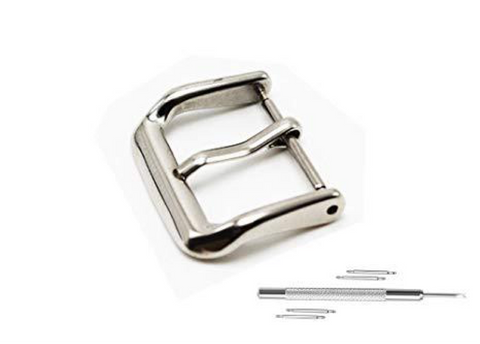
TheArdillon loopIs by far the most common type of clasp in watchmaking (except steel bracelets). It consists of a metal rod, the barbless, which fits into the holes of the bracelet according to the size of your wrist. This is the same system as the belts. It's a Simple claspVery comfortable, suitable for all wrists. On the other hand, it tends to use the bracelet, must be pruned every time and does not hold the watch on your wrist if it opens accidentally.
THE SIMPLE DEPLOYABLE LOOP CLASP
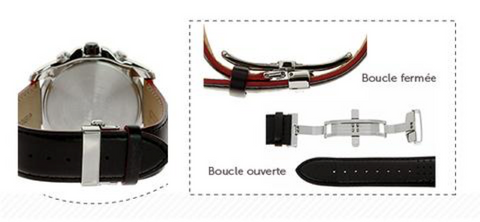
The Simple deployer loopIs the most common type of fermoir on steel bracelets. This ClaspConsists of an articulated system that deploys and folds on itself, from a single holding, through lateral pressures or through a safety flap. This allows you to avoid the risk of falling on your watch in the event of a sudden opening. Like a barbless loop, it does not mark the bracelet. On the other hand, if the bearer has a small wrist, it can be less comfortable and more difficult to move to the hand.
THE DUAL-LOOP CLASP

TheDual deployer loopIs a variant of the simple deployer loop. This type of fermoir has a double articulation attached to a main block, which is an additional system for opening/closing in two times and now the whole of a single block once closed. It's a ClaspVery aesthetic that also allows you to avoid the falls of your watch in case of accidental opening. On the other hand, if the curvature does not marry your wrist, the main block can cause discomfort.
THE INVISIBLE LOOP BUTTERFLY

The Invisible loop butterflyIs a quasi-identical system to the dual deployer loop. The only real difference is that once closed, the loop is not visible thanks to a concealed attachment. It unfolds and refolds with two fins slightly larger than the bracelet. Very used on ceramic bracelets, it's a Elegant claspBut not widespread because it is more complicated to use and to less comfort. In particular, it tends to be opened accidentally.
THE CLIP CLASP
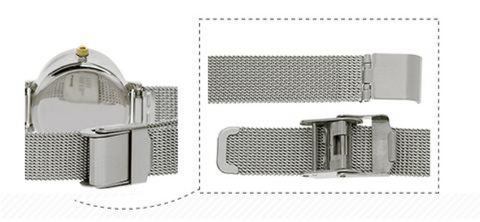
Mostly used on watches equipped with steel bracelets, the Clip claspConsists of a lever system to open or close the watch. The waising is done only once thanks to a sliding system on the bracelet. It's a Type of claspWidespread on milanese mesh bracelets, highly appreciated by fashion brands. On the other hand, the clip-clasp is essentially used on low-cost watches and thus less solid than others such as the barbless loop or the deployed loop.
HOW DO YOU CHANGE THE CLASP OF YOUR WATCH?

The clasps (except for clip ones) are fixed thanks to a pump, just like the wristbands of the watch at the horns (in the majority of the cases at least). For Replace your clasp, you must first check the width of this one because it is possible that it is different from the width of the sprawl if the bracelet is collapsing towards the loop. Once the size is known and the new clasp is in hand, use a Pose postIn the holes on the side of the loop, then push inward to get the pump. In some cases, the buckle is fixed by screws, so you just have to use a screwdriver. Once the loop dislodged from the bracelet, you just need to reuse the teeth of the laying post to put the bracelet back. If you do not have such a tool, a cutting edge knife can do the business, but the operation will be more delicate and you risk removing the buckle or wristband; do so slowly and without forcing history of not injuring yourself.
WATCHES THAT PASS FROM CLASPS
Some watches are bold and dare to be displayed without a clasp.
The cases are rather rare, and this makes the pieces very interesting in terms of style.
There are jonc-like systems, rigid leather bracelets, and elastic bracelets.
If you need more information our watchmakers are your Provision.
Any watch repair quote is free








